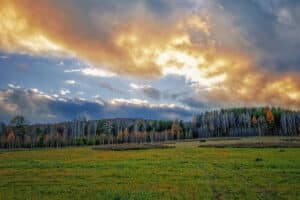Let’s say you are looking at an 80 acre tract of rural land for sale that has not been surveyed. Should you purchase a survey before buying? The answer is, “it depends”.
Source of the Acres
The advertised acres may come from authoritative sources such as a deed or the county tax office. But most deeds assume that a “forty” (1/16 of a section) is 40 acres when, in fact, very few “forty’s” are actually 40 acres. The tax office may use expensive software to estimate acres, but we’ve seen tax acres be significantly wrong. Fact is, unless a land survey is done, no one knows exactly how many acres are present in the property.
In some rural areas, most properties have never been surveyed. The reason is because surveys are expensive ($3,000 to $6,000 for our 80 acre example) and the precision may not be that important to many people.
Tips to Keep in Mind
- Be sure the precision matters. Let’s say you just spent $3,000 to learn that your 80 is really 78. You probably haven’t gained much.
- Do a “rough check” on acres. You can do this by plotting the boundary lines on an aerial photo (like Google Earth or Bing). By using “use lines” as a guide (for example, a neighbors pasture edge or an adjoining recent timber harvest), you can plot the lines and use the photo scale to estimate acres. Or, walk the lines looking for old wire fences and rock-pile corners. If you can find physical evidence of lines on the ground, then you can pace the lines (or use a hand-held GPS) to get a rough check. Also, there are commercial “topo” software programs available that you can use to plot the boundary lines and calculate acreage. These are especially useful if you have also ground checked the lines. Your forester or rural land broker can help with performing a “rough check”.
- Sometimes a survey is prudent. If your rough check raises concerns (or you can’t get a rough check), or your lender requires a survey, or you are uncomfortable with the ambiguity, then a survey may be in order. A situation where extra precaution can be justified is when one or more property boundaries is the run of a large creek or river. These can change course over the years, and a 100 year old deed may no longer contain the correct acres. Or, when a physical inspection reveals that neighbors may be “possessing” over the line.
Also, keep in mind that in today’s world, surveys are made by locating property corners with a GPS. This has lowered the cost of getting an acreage estimate because surveyors don’t have to “run the lines”. They just go to the corners. But, if locating or marking property lines is important to you, make sure your surveyor has been retained for this task too.
Avoid the cost if you can
Our experience is that with a little effort, most people can gain a level of comfort with the advertised acres and thus avoid the expense of a survey.
This article is an excerpt from Tom Brickman’s e-book, “Buying Rural Land: Tips and How-to’s”, a collection of well-written, quick reads to help you find a rural property you’ll love and simplify getting it done. Download the e-book and learn from a seasoned pro with 40 years of experience.
This content may not be used or reproduced in any manner whatsoever, in part or in whole, without written permission of LANDTHINK. Use of this content without permission is a violation of federal copyright law. The articles, posts, comments, opinions and information provided by LANDTHINK are for informational and research purposes only and DOES NOT substitute or coincide with the advice of an attorney, accountant, real estate broker or any other licensed real estate professional. LANDTHINK strongly advises visitors and readers to seek their own professional guidance and advice related to buying, investing in or selling real estate.










Tom,
I think the focus of the question “Do you need a survey?” is not pertaining to the acreage justification but more towards encumbrances and identifying property corners. I am a professional land surveyor and I have seen more problems in land transactions than I care to. The majority of land transactions today are not requiring a survey before closing. Attorneys are conveying title using an older legal description from record and saving time and money for the transaction with an option of Title Insurance to cover limited issues that arise later. If any issues come up down the road it will be entirely on the effort of the land owner to facilitate the process. The closing attorney is out of the picture and will not help without compensation. Land is one of our biggest investments and the preliminary steps must be taken to insure that investment is what is advertised. I am not saying this because I am a surveyor but because a real estate agent, builder or seller can tell the potential buyer how many acres, the property line is here or there aren’t any issues with title without any credentials or liability……please get a survey before buying a piece of property so you know what you are purchasing. I would rather know the encumbrances and property corner locations relative to the property than taking the word of a person that is free of liability.
Not trying to be negative about this article, but I have been in the land surveying / land development / real estate business for 20+ years and this is the worst advice you could give your clients who are looking to invest money into large tracts of land. As you did accurately state, most property assessment acreages and deeds are close, but some are way off. Also, is your client purchasing the land by lump sum or by the acre price. Your example of rural properties not being surveyed because they are expensive is a very relative statement. What is the price per acre of the land being purchased or are you buying “deeded” acres or “surveyed” acres? If you spent $3000 for a survey and are purchasing the “80 Acre” tract on surveyed acres, depending on the price per, you probably paid for the survey and saved money if the tract comes up with less acreage than deeded. You state in today’s world that surveys are made by locating property corners with GPS and surveyors only go to the corners with the GPS equipment, keep this in mind, the surveyor is utilizing about $50,000 worth of GPS equipment and accessing up to 24 satellites, not a handheld Garmin. And yes, we are required by law to “run the lines” when performing a survey. We are required to locate fences along property lines, encroachments along property lines, ingress along property lines, utilities along property lines, adjoining property corners along the subject property. Not getting a survey on a large acreage property that has not been surveyed recently just to save a few thousand dollars is very poor decision making on the buyers part or very irresponsible advice on the agents part. This article disregarding surveys because Google Earth makes you feel good is no different than someone selling their land without obtaining sellers representation (agent) so they can save that few thousand dollars in commission.
I only wish I can find a honest surveyor to work for me in PA on either a 175 acres or the original 194 acre farm. The first survey was done (1985) on the neighbors farm, after he passed away and never had any recorded deed. A want to be surveyor gave his property additional property and never asked the neighbors for any input. I have spoken to the original owner of now our property and he said his property was surrounded by a fence required under Pa. law up until recently. I followed the fence line and tax maps and found all the corners. I confronted my neighbor he hired a surveyor. That surveyor refused to talk with the former owner and said he would not look at the corners and the survey from 1985 stands. He would not provide the neighbor with a new survey and I am unable to find another surveyor to work for me, because I am a non-resident and every surveyor knows the guy that did the neighbors property. I am asking for a retracement survey.
You can learn a lot by reading the deed description, if the units are poles, angles are to the degree (no minutes & seconds) then its an old survey. If you plot it and the closure error is 1,000 feet then you know there are problems. If corners are things like “an 18 inch black gum”, then realistically the corners may no longer be marked. So at this point you really don’t know what you are buying or where it starts or ends.
Then what is it you are buying – cutover timberland for hunting, paying $400/acre in a remote area, then maybe a survey is optional. Significant timber value, water frontage, major easments and encumbrances, or structures near a border one would be nuts not to get a survey.
Thanks for replying. We welcome you to pen a rebuttal article with your professional advice and opinion and submit it to LANDTHINK for inclusion. Please keep this article in perspective. Also keep in mind the premise of the article is to offer basic “tips” around if you should get a survey or not – not solely to determine acreage or define all the other endless variables that could arise from a property survey. It’s possible surveys done at the same time by more than one surveyor can yield different results. Who’s right? It’s important to note that the gentleman who wrote this article has been in the land real estate, appraisal, and timber business for over 40 years. He’s been on both sides of the survey proposition more times than most and fairly successful assuming longevity matters.